The Huawei Mate 8 Review
by Andrei Frumusanu on January 5, 2016 1:00 PM EST- Posted in
- Mobile
- Smartphones
- Huawei
- Cortex A72
- Kirin 950
- Mate 8
- CES 2016
Display Measurement
The Mate 8 sports a 6” diameter 1080 x 1920 pixel resolution screen manufactured by JDI. This is again an IPS-Neo LCD screen which is supposed to offer higher contrast ratios compared to other LCD technologies. The display driver IC is NovaTek’s NT35695, the same one found in other devices such as last year’s Mate 7, the P8 or HTC One M8. The DDIC supports and is run in MIPI command mode, thus supporting panel self-refresh (PSR).
It actually seems as that the Mate 8 employs a very similar, if not actually the same display as the one found on the Mate 7 as at first glance it’s hard to distinguish between the two screens as they both seem to offer the same viewing experience. This also includes the same viewing angles as found on the Mate 7, which offered one of the best experiences among LCD devices.
Huawei went with an AMOLED screen on the Mate S which offered substantially better viewing angles and overall display experience, but came at a price of extremely high power consumption as Huawei opted to use a less efficient display panel from Samsung. For the Mate 8, I think that sticking with an LCD was a wise choice as the Mate series is focused on battery life and such a large AMOLED display would have limited the device’s power efficiency.
2015 was a year where we saw the mainstream adoption of 1440p screens in many flagships, so it’s a bit odd to have Huawei still go with 1080p on the Mate 8. While this is a completely subjective matter and for many people the resolution is enough, I would have liked to see some improvement as 1080p on a 6” display such as the Mate 8 is stretching it quite a bit and visible to me when holding the device close up at about 25cm. Here’s hoping next year’s Mate manages to make the switch to 1440p.
Our display testing is done with an X-Rite i1Pro 2 spectrophotometer as our measurement hardware, in conjunction with SpectraCal's CalMAN software suite and our own workflow to be able to get an accurate display characterization.

In terms of maximum brightness the Mate 8 gets pretty bright as it’s able to show a luminosity of up to 522 cd/m². This is slightly higher than the Mate 7 and on par with some of the brightest LCD displays on current smartphones.

The black levels on the Mate 8 are slightly worse than the ones found on the Mate 7 – this is partly due to the fact that the Mate 8 gets brighter but I also think there are small differences in the panel itself. For example, the Mate 8 is much more homogeneous and displays less backlight bleeding than the Mate 7, especially around the edges of the display.
At minimum brightness the black levels reach very low values so the IPS-Neo panel is able to perform well in terms of maintaining high contrast at low luminosities. I was a bit disappointed that the minimum luminosity reached only 10 cd/m², which can still be quite bright when browsing in bed at night. I think the low value of 2 cd/m² targeted by other manufacturers is a sweet spot for comfortable night viewing, and as I’ve mentioned in past Huawei reviews, I’m still hoping that we’ll be eventually able to see this change in future devices from the company.
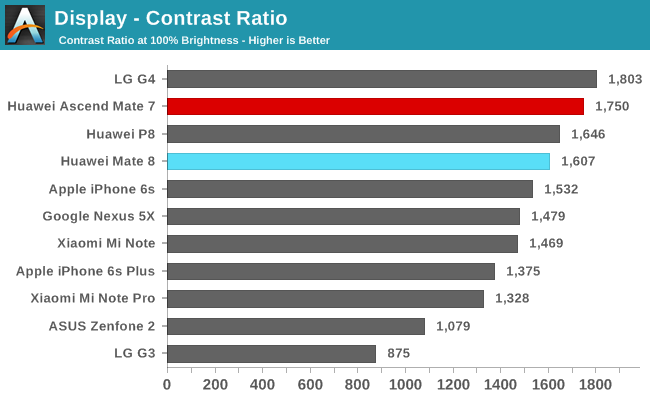
Contrast ratio ends up at 1607:1 at maximum brightness, a good value in itself but still a bit lower than the Mate 7. I wonder if Huawei will in the future make more usage of AMOLED panels as it would greatly benefit this aspect of the device display quality.
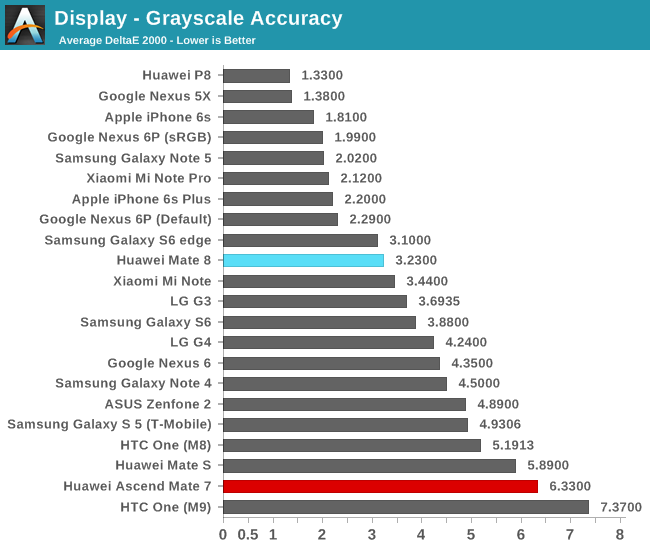
Moving on onto the grayscale accuracy testing we see the Mate 8 performs averagely. At 200 nits the average gamma is higher than the desired 2.2 target making content darker and colours more saturated. Only at minimum brightness does gamma near an average of 2.2, but here we see a skewed gamma curve where lower luminosity values overshoot the target and thus become darker than intended, and higher luminosity values are brighter than intended.
The greyscale accuracy reports a dE2000 of 3.23 at 200 cd/m². Oddly enough it seems the screen is more accurate both at minimum and maximum brightness. While falling around average among today’s flagship devices, this is much better than last year’s Mate 7 as the predecessor device suffered from a severe green tint which brought down both the measured colour accuracy as well as the overall screen experience.
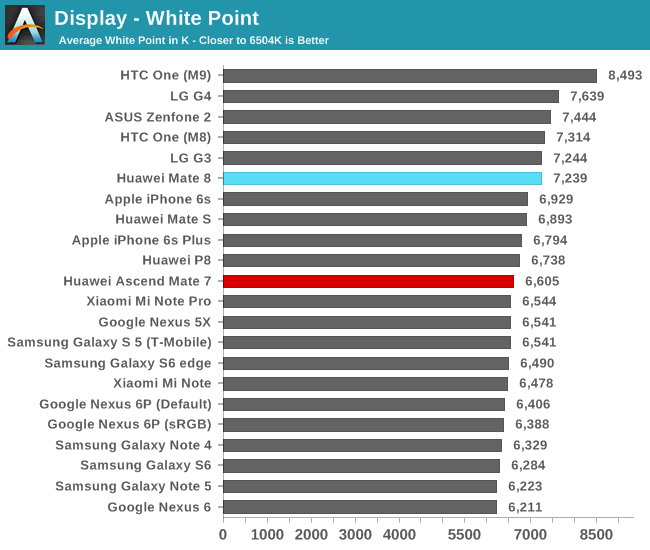
While the Mate 7 averaged a colour temperature default of 6605K (with very green whites), the Mate 8 is configured at a higher 7239K, displaying colder whites that tend towards blue. For people who like to adjust colour temperature Huawei again exposes a control slider for this. Unlike the P8 where you could hit outstanding display accuracy when configuring the slider to the warmest possible value, the Mate 8 is again a shot in the dark as hitting 6504K is a quite difficult task without proper display calibration equipment.
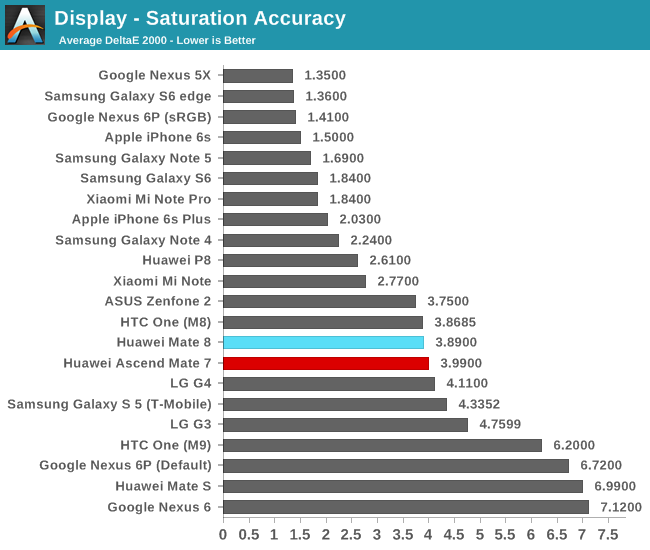
The Mate 8 comes with a wide gamut display calibration and thus saturation accuracy against our sRGB target is quite off with a dE2000 of 3.89. I wasn’t able to determine to what standard Huawei tried to calibrate the gamut to as it doesn’t match either DCI nor AdobeRGB, so it must either be the panel’s native gamut or some other standard we haven’t tested yet.
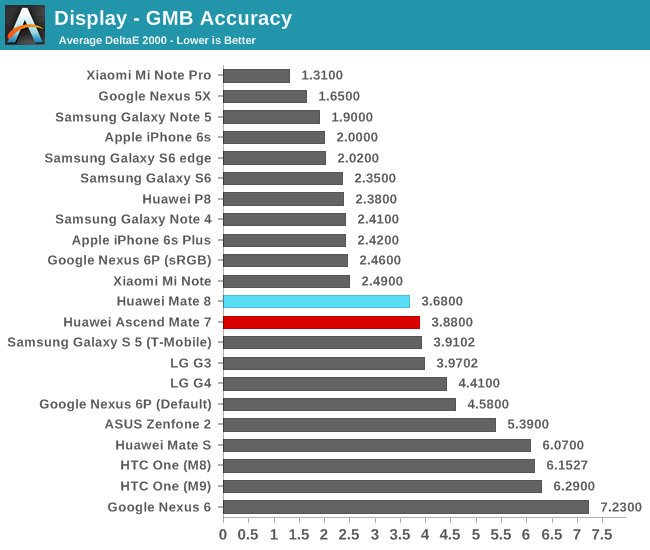
Finally the Gretag McBeth benchmark of commonly encountered colours such as skin tones of foliage shows a dE2000 of 3.68 which is slightly better than that of the Mate 7. As seen in our colour comparison strip, it seems that it’s especially the higher gamma which has an effect on the perceived colours as they’re all darker than the targeted values.
Overall the Mate 8 is a good screen. It seems that Huawei deliberately didn’t calibrate it for more accurate colours as it’s likely the general populace prefers wider gamuts with more saturated colours. Still the screen represents some improvements over the Mate 7 – it’s a brighter and more homogenous display (on our review samples) and it also fixes the green tint observed in last year’s device. Given the screen size it’s reasonable for Huawei to have gone with an LCD screen, although after seeing the Mate S I would like to see an eventual switch to AMOLED, that is if they’re able to choose an efficient panel. The 1080p resolution on the 6” screen is also somewhat outmatched in sharpness by competing devices, so again while this is a subjective matter, it’s definitely something to consider, especially when one is used to read with the device close up.
Display Power
As mentioned before, going with an LCD panel is required if one is focused on battery life as AMOLED displays still haven’t quite reached sufficient efficiency levels to say that they always outperform LCD screens. The Mate 8’s 6” screen is especially prone to this as going AMOLED would have increased peak power quite a lot, as well as considerably increasing the device’s bill of materials.
| Screen Luminance Power Efficiency 100% APL / White |
||||||
| Device | Screen Luminance Power at 200cd/m² |
Luminance Power (mW) / Screen area (cm²) Efficiency |
||||
| Huawei Ascend Mate 7 | ~379 mW | ~3.82 | ||||
| LG G4 | 354 mW | 4.11 | ||||
| Meizu MX4 | 345 mW | 4.14 | ||||
| Huawei Mate 8 | ~419 mW | ~4.22 | ||||
| Huawei P8 | ~341 mW | ~4.43 | ||||
| Meizu MX4 Pro | 386 mW | 4.47 | ||||
| Samsung Galaxy Note 5 | 504 mW | 5.64 | ||||
| Samsung Galaxy S6 | 442 mW | 5.99 | ||||
| Huawei Nexus 6P | ~615 mW | ~6.88 | ||||
| Samsung Galaxy S5 | 532 mW | 7.21 | ||||
| Samsung Galaxy Note 4 | 665 mW | 7.22 | ||||
| Samsung Galaxy S5 LTEA | 605 mW | 8.20 | ||||
| LG Flex 2 | 765 mW | 8.89 | ||||
| Samsung Galaxy S4 | 653 mW | 9.22 | ||||
| Huawei Mate S | ~769 mW | ~9.24 | ||||
For this test I went ahead and measured the luminosity curve on the Mate 7 as well so that we can have a comparison between the two device generations, and oddly enough it seems that the Mate 8 actually regressed in efficiency. Due to not having the opportunity to dismantle the device and hook up my power measurement equipment to it, I thus had to rely on the device’s own fuel-gauge. While this seemed seemingly accurate for the CPU and GPU figures, it’s odd to see the Mate 7 actually outperform screens such as LG’s latest generation panel in the G4 but may very well be possible due to the lower pixel density allowing better light transmission through the screen’s TFT matrix.
The Mate 8 seems to fall more in line with other measurements of LCD devices, displaying an estimated luminance power efficiency of ~4.22 mW of power for each cm² of screen area. At full brightness the Mate 8 uses 1541mW, of which ~1140mW can be attributed to the backlight.
Overall the Mate 8’s screen efficiency lands where we expected it to be for an LCD display and thus should be able to allow the device to perform well in our battery benchmarks.



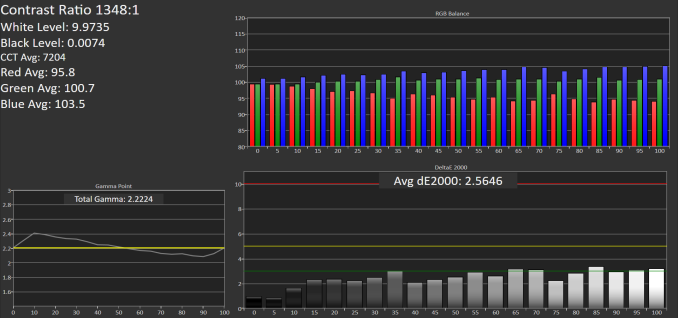

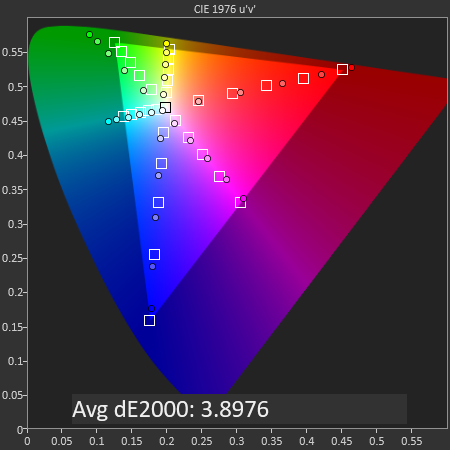


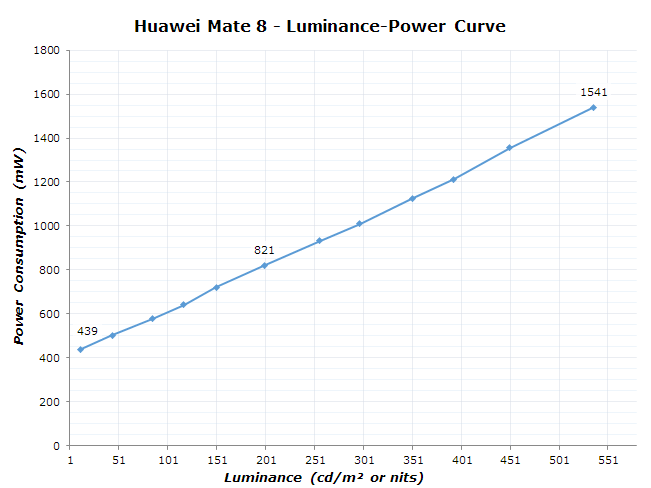








116 Comments
View All Comments
lilmoe - Tuesday, January 5, 2016 - link
CCI (Cache Coherent Interconnect) is basically responsible for connecting and "shifting" load between CPU clusters (, GPU and various other compute blocks) in a big.LITTLE configuration based on compute load needs.For the rest, Google is your friend.
name99 - Tuesday, January 5, 2016 - link
Andrei, do you always use the same compiler, version, and settings for the SPECInt2000 measurements?The reason I ask is if you compare these results to the A9 results
http://www.anandtech.com/show/9686/the-apple-iphon...
things are mostly as you'd expect except 300.twolf and (especially) 175.vpr
The latter in particular is discrepant enough that the only thing that seems like it might have caused it is a substantial compiler optimization like a loop re-ordering.
Andrei Frumusanu - Tuesday, January 5, 2016 - link
On Android we use the same binaries unless we specify some flag changes which happen over longer periods (Last change was in August). Generally we try to publish a given article with apples-to-apples scores.For iOS it's impossible to use the same compilers and we have to rely on Apple's LLVM. It's very possible that Apple's scores are higher due to better optimizations. I have in mind to try LLVM on Android (currently it's GCC) but it's something of a long-term project rather than something we can just switch to and even then it will never solve the optimization issue as Apple's LLVM toolchain has additions that we simply can't keep track of.
name99 - Tuesday, January 5, 2016 - link
To add to my point, compare withhttp://www.anandtech.com/show/9330/exynos-7420-dee...
Here the Exynos 7420 SPECInt2000 numbers are sometimes EXTREMELY different (like sometimes over a factor of 2, eg 175.vpr) from the Exynos 7420 A57 numbers you give in this article.
Maybe it would be good form, going forward, to publish this information, just so we can all keep track. (And obviously it is interesting to see when LLVM results differ greatly from gcc results, or even when the LLVM results show a great jump.)
Obviously one can't hope for PERFECT LLVM parity. Certainly Apple are keeping the back-ends of the compiler toolchain (Typhoon and Twister, maybe even the current Cyclone and Swift back-ends) secret; and given that they use a slightly different linker, there may be differences in exactly how, eg, they handle LTO. But one would expect mostly similarity between the Apple and Android LLVM, and rather more difference with gcc.
My point is not some sort of "rah rah Apple"; it's more just a desire to understand. For example, IS it the case that gcc happens to have some sort of (presumably fairly recent) optimization that managed to double the 175.vpr result? (And if so, what's the nature of that optimization.)
I think we'd all be curious to know, for example, whether you use LTO in building these SPECInt2000 binaries. And whether, if you use PGO, you get a substantial boost in performance.
Andrei Frumusanu - Wednesday, January 6, 2016 - link
There were issues with the 7420 harness that caused us not to immediately catch validation failures and it treated the runtime as if the test were simply faster. SPEC is relatively complex so unfortunately such problems do happen.RdVi - Tuesday, January 5, 2016 - link
Nice improvements from Huawei. If the P9 can keep this up while being no larger than the P8, it might be my next phone.SHartman1976 - Wednesday, January 6, 2016 - link
No complaint about the power and volume buttons being on the same side? That seemed to vex you on the Nexus 6P a couple of weeks ago despite it being a recurring design choice.Andrei Frumusanu - Wednesday, January 6, 2016 - link
My complaint on the 6P wasn't them being on the same side, it was that the volume buttons were extremely low on the phone and positioned below the power button, an odd positioning that kept one pressing the volume buttons when holding or picking up the phone. The Mate 8 has a traditional layout which doesn't cause any issues.raghwendra123 - Wednesday, January 6, 2016 - link
When should we expect the iPad Pro review?Piscupescu - Wednesday, January 6, 2016 - link
Nice review. Keep up the good work.